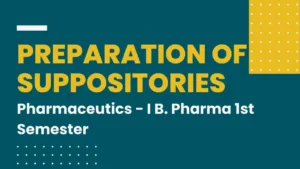Preparation of Suppositories

Learning objectives
At the end of this lecture, student will be able to:
• List the methods of suppositories preparation
• Discuss methods of suppositories preparation
• Discuss packaging, storage conditions
Explain the quality control test for suppositories
Methods of preparation of suppositories
Four methods are used in preparing suppositories –
1. Hand moulding [Cold Hand Shaping]
2. Compression moulding
3. Pour moulding (Fusion method)
4. Automatic moulding machine
Hand moulding [Cold Hand Shaping]
• Drug is triturated in a mortar into fine powder
• Cocoa butter is grated into small particles
• Drug is mixed with small portion of cocoa butter in a mortar
• One drop fixed vegetable oil is added to give plasticity to the mass
• Remainder of the cocoa butter is added by geometric dilution and triturated with pressure
• Heat generated by trituration results in a plastic mass, which is cohesive and ready to roll
The mass is scrapped from the mortar with a spatula and rolled into a ball
An ointment tile is taken, dusted lightly with starch powder, ball is placed on it, rolled with a flat faced spatula to form a cylinder
The cylinder is cut into desired number of pieces with a sharp blade
One end of a suppository is held firmly with a finger and the other end is tapered with the spatula to give the shape of suppository
Compression Moulding
• Drug is powdered and mixed with grated cocoa butter
• The mixture is filled into a chilled cylinder and is pressed within the cylinder by a piston until a pressure is felt
Then the suppositories are expelled from the cylinder
Pour moulding (Fusion method)
• This is the main method of preparing suppositories.
• Drug is powdered in a mortar.
• Carefully grated cocoa butter is taken into a china dish and heated in a water bath.
• When 2/3rd portion is melted the china dish is taken out of the heat source.
• The rest of the mass is melted by stirring with a glass rod.
• [If cocoa butter is heated to clear liquid then unstable α and γ – crystals will form and the suppositories will remain in melted state at room temperature.]
• Drug is added into the beaker and stirred thoroughly to mix with the “creamy” base.
• The “creamy” melted base is then poured into previously lubricated mould.
• The mould is allowed to congeal, then placed in the refrigerator for 30 minutes to harden (forms stable β-crystal after refrigeration).
• Mould is taken out from the refrigerator and surface is trimmed off.
• The mould is opened and the suppositories are expelled out of the mould by gentle pressure with the finger.
Automatic moulding machine
Two types of moulding machines are available:
a) rotary moulding machine
b) straight-line moulding machine
Manufacturing cycles in rotary moulding machine:
• Prepared mass is filled into a filling hopper where it is continuously mixed and maintained at constant temperature.
• The suppository moulds are lubricated by brushing or spraying lubricant solution.
• The molten mass is filled in the moulds to a slight excess.
• The mass is cooled to solidify and the excess material is scrapped off and collected for re-use.
• In the ejecting section, the mould is opened and the suppositories are pushed out by steel rods.
• The mould is closed, and then moved to the first step of the cycle.
q The output of a typical rotary machine ranges from 3500 to 6000 suppositories an hour.
q Here the cycle is similar to rotary moulding machine but the individual moulds are carried on a track through a cooling tunnel, where scrape-off and ejection occur.
Suppositories filling machine
Suppository shapes
Packaging requirements
q Bulk storage: The individually wrapped suppositories are packaged in slide, folding, or set-up boxes.
q Suppositories containing hygroscopic or volatile material are packed in glass or plastic containers.
q Suppositories are not individually over-wrapped.
q They are placed in sectioned card-board boxes or plastic containers to hold 6 or 12 suppositories.
In-package moulding method
Advantage:
• If the suppository melts at higher storage temperature their shapes are retained which can be used just by chilling again
Suppositories
Storage of suppositories
q Suppository should be protected from heat, preferably stored in the refrigerator
Quality control tests for suppositories
1. Visual Inspection test
2. Disintegration test
3. Uniformity of mass
4. Uniformity of drug content
5. Melting Point determination Test
6. Liquefaction / softening time test
7. Fragile/ breaking test
Summary
Four methods are used in preparing suppositories –
1. Hand moulding [Cold Hand Shaping]
2. Compression moulding
3. Pour moulding (Fusion method)
4. Automatic moulding machine
Quality control tests for suppositories
1. Visual Inspection test
2. Disintegration test
3. Uniformity of mass
4. Uniformity of drug content
5. Melting Point Determination Test
6. Liquefaction / softening time test
7. Fragile/ breaking test
FAQs
- Are suppositories safe for all age groups? Suppositories are generally safe but consult a healthcare professional for specific advice.
- Can suppositories be used for over-the-counter medications? Some suppositories are available without a prescription, but it’s crucial to follow guidelines.
- Do suppositories have a distinct odor? The odor varies based on the ingredients used but is generally minimal.
- What should I do if a suppository melts before use? Contact your pharmacist for guidance on whether it’s safe to use or needs replacement.
- Can I cut a suppository into smaller pieces for a lower dosage? It’s not recommended, as it may affect the uniformity of dosage and efficacy. Consult your healthcare provider for dosage adjustments.
Also, Visit:
B. Pharma Notes | B. Pharma Notes | Study material Bachelor of Pharmacy pdf





Hi i need soft copy of this material
how can i get it.
For shoft copy join Telegram Channel